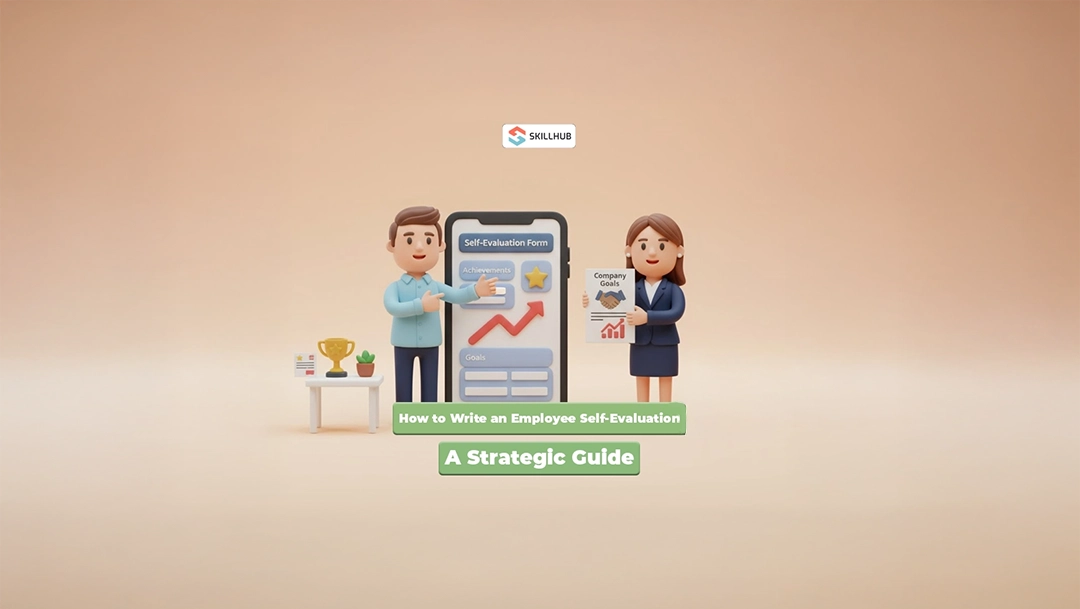How to Write an Employee Self-Evaluation: A Strategic Guide to Showcasing Your Value

For most professionals, the annual "self-evaluation" is a source of anxiety, confusion, and dread. It feels like an awkward, bureaucratic chore an exercise in trying to remember what you did six months ago while attempting to sound humble yet impressive. This is a massive, career-limiting mistake. A self-evaluation is not a confession; it is a proposal. It is the single most important internal document you will write all year.
This is not a historical report; it is a strategic argument. It is your formal business case for a raise, a promotion, or assignment to high-visibility projects. A lazy, generic, or poorly written self-assessment doesn't just get filed away; it actively damages your professional brand. It signals to your manager that you are not engaged, not strategic, and not the "A-player" they thought you were.
Conversely, a masterful self-evaluation one that is data-driven, strategically aligned with company goals, and framed with confidence makes your manager's job easy. It gives them the exact language and metrics they need to champion you to their bosses. This guide provides a definitive framework for transforming your self-evaluation from a painful chore into your most powerful career-advancement tool.
The Foundational Shift: From "What I Did" to "The Impact I Had"
The primary failure of most self-assessments is that they are a simple list of duties or tasks completed. Your manager already knows what your job description is. They do not need a list of the meetings you attended or the reports you filed. They need a curated list of your impact.
- Weak (Duty-Focused): "I was responsible for managing the team's social media accounts and creating content."
- Strong (Impact-Focused): "I owned the social media strategy and grew our organic channel engagement by 45% YOY by identifying and leveraging a new video content pillar, which directly contributed to a 10% increase in marketing-qualified leads."
Your self-evaluation is the story of your results. To tell this story, you must be tracking your accomplishments all year long.
Do not wait until the week before your review to try and remember your successes. You will fail. Keep a 'Brag File' a simple document or folder where you save every piece of positive feedback, every quantified win, and every project milestone. Your self-evaluation is written in small increments over 12 months, not in one panicked night.
The 5-Step Strategic Framework for Writing Your Self-Evaluation
Do not start with a blank page. Follow this process to build a compelling and irrefutable case for your value.
Step 1: Deconstruct Your Goals and the Company's Goals
Your self-evaluation must be framed in the language of the business. Before you write, gather three documents:
- Your Job Description: What are you formally paid to do?
- Your Goals from the Last Review: What specific objectives did you and your manager set?
- The Company's/Department's OKRs or Goals for the Year: What does your boss's boss care about? (e.g., "Reduce Churn," "Increase Market Share," "Improve Operational Efficiency").
Your goal is to create a "golden thread" that explicitly links your daily work (Document 1) to your personal goals (Document 2) and, most importantly, to the company's high-level strategy (Document 3).
Step 2: Adopt the STAR Method for Achievements
Just like in a behavioral interview, the STAR method (Situation, Task, Action, Result) is the perfect framework for structuring your accomplishments. For a self-evaluation, we can simplify it to PAR (Problem, Action, Result).
- Problem: What was the specific problem or challenge the business faced?
- Action: What specific, high-level action did you take to address it?
- Result: What was the quantifiable, positive outcome?
Example:
- (Problem): "The sales team was wasting time manually logging calls, leading to inaccurate data."
- (Action): "I took the initiative to research, pilot, and implement a new CRM integration tool."
- (Result): "This automated the process, saving an estimated 5 hours per rep per week and improving our data accuracy by 95%."
Use this framework for your top 3-5 achievements of the review period. These form the core of your document.
Step 3: Quantify Everything (The Non-Negotiable Step)
Numbers are the language of business. They are objective, persuasive, and undeniable. Vague, subjective claims are easy to dismiss. Data is not.
You must dig for these numbers. Look at analytics, project reports, or even your own email history. This data-driven approach is the only way to prove your value and sets the stage for any discussion about your greatest strengths.
Step 4: Be Honest About Shortcomings (But Frame Them Strategically)
This is the section everyone fears. Do not make these mistakes:
- The "Fake" Weakness: "My weakness is that I work too hard" or "I'm a perfectionist." This is a transparent and insulting cliché.
- The "Blame Game": "I missed the deadline because the marketing team failed to deliver their part." This shows a lack of accountability.
The correct strategy is to choose a real, minor weakness, show you are aware of it, and most importantly, detail the proactive steps you are taking to fix it. This demonstrates self-awareness and a growth mindset, which are highly valued leadership skills.
Strategic Weakness Framework:
- Identify the Weakness: "I struggled this year with public speaking, especially in large, cross-departmental meetings."
- State the Impact: "I recognized this was limiting my ability to champion my team's projects effectively."
- State the Action Plan: "To address this, I have enrolled in a Toastmasters course and have volunteered to present at the next two team all-hands meetings. I am also working with my mentor to practice my presentations."
This turns a weakness into a story of proactive professional development.
Step 5: Write Your Future Goals
The self-evaluation is not just about the past; it's about the future. This is where you signal your ambition and align your personal goals with the company's.
- Be Specific: Don't say, "I want to get promoted."
- Be Strategic: Say, "My goal for the next year is to take on a formal leadership role. I plan to achieve this by mentoring two junior team members and taking the lead on the upcoming 'Project Titan,' which I believe is critical to our department's 2025 goals."
This frames your ambition as a benefit to the company, not just to you.
The Expertise Barrier: The Fear of "Bragging"
Many professionals, especially women and minorities, are socially conditioned to avoid self-promotion and "bragging." They soften their language, use "we" instead of "I," and downplay their own accomplishments. This is a fatal error in a self-evaluation.
- Use "I," not "We." This is a self-evaluation. The company knows you work in a team. Your manager needs to know what your specific, individual contribution was. "We" hides your value. "I" claims it.
- Facts are not Bragging. Stating, "I grew revenue by 30%" is not bragging. It is a fact. It is data. You are not saying, "I am a genius"; you are saying, "Here is the measurable result of my work."
This is a technical writing exercise, not a personal one. You must be objective and confident. For many, this is the most difficult part. They struggle to find the right tone and end up writing a document that undersells their value.
Putting It All Together: A Final Checklist
Before you hit "submit," review your draft against this final checklist.
- [ ] Is it Data-Driven? Is every major claim backed by a number, percentage, or dollar amount?
- [ ] Is it Aligned? Does it clearly connect your work to the department's and company's top priorities?
- [ ] Is it About Impact, Not Duties? Have you deleted all passive, task-list language?
- [ ] Does it Use "I"? Have you taken credit for your specific contributions?
- [ ] Is it Forward-Looking? Does it set clear, ambitious goals for next year?
- [ ] Is it Honest? Does it strategically address a real weakness with a clear action plan?
Conclusion: The Author of Your Career Story
Your self-evaluation is your single best opportunity to be the author of your own career story. It is a strategic proposal, a data-driven argument, and a business case for your own advancement. Do not treat it as a chore. Treat it as the most important piece of writing you will do all year, and it will pay dividends in the form of recognition, raises, and promotions.
Ready to make your self-evaluation an undeniable case for your promotion? Consult with a Skillhub Career Expert today.
%20(1).png)



%20(1).webp)